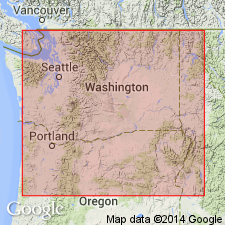
- Usage in publication:
-
- Weissenfels Ridge Member*
- Modifications:
-
- Named
- Dominant lithology:
-
- Basalt
- AAPG geologic province:
-
- Eastern Columbia basin
Summary:
Pg. G6-G7 (fig. 2), G44-G45. Weissenfels Ridge Member of Saddle Mountains Basalt of Yakima basalt subgroup [informal] Columbia River Basalt Group. Occurs in Lewiston basin of Washington and Idaho. Consists of 3 or more coarse-grained, sparsely to moderately plagioclase-phyric olivine basalt flows. Thickness 34 m at type; averages 10 to 15 m. Informally subdivided into (oldest to youngest): (1) basalt of Lewiston Orchards, a coarse grained, sparsely plagioclase-phyric flow, 10 to 37 m thick, occurs chiefly in western Idaho; and (2) basalt of Slippery Creek, includes Camp's (1976) Uniontown-3 flow, averages about 10 m, occurs in extreme southeast Washington. Occurs above Asotin Member and below Elephant Mountain Member, both of Saddle Mountains Basalt. Has normal magnetic polarity. Age is middle Miocene.
Type locality: in roadcuts along Weissenfels Ridge, in NW/4 sec. 24 (projected) and NE/4 sec. 23 (projected), T. 9 N., R. 46 E., Capitan John Rapids quadrangle, Asotin Co., southeastern WA.
[Yakima basalt subgroup considered informal and should not be capitalized. "Subgroup" not recognized as a formal stratigraphic rank term (CSN, 1933; ACSN, 1961, 1970; NACSN, 1983, 2005, 2021). Columbia River Basalt Group adopted by the ID, OR, and WA Geol. Surveys, and the USGS.]
Source: Publication; US geologic names lexicon (USGS Bull. 1564, p. 184); Changes in stratigraphic nomenclature, 1979 (USGS Bull. 1502-A, p. A84).
For more information, please contact Nancy Stamm, Geologic Names Committee Secretary.
Asterisk (*) indicates published by U.S. Geological Survey authors.
"No current usage" (†) implies that a name has been abandoned or has fallen into disuse. Former usage and, if known, replacement name given in parentheses ( ).
Slash (/) indicates name conflicts with nomenclatural guidelines (CSN, 1933; ACSN, 1961, 1970; NACSN, 1983, 2005, 2021). May be explained within brackets ([ ]).

